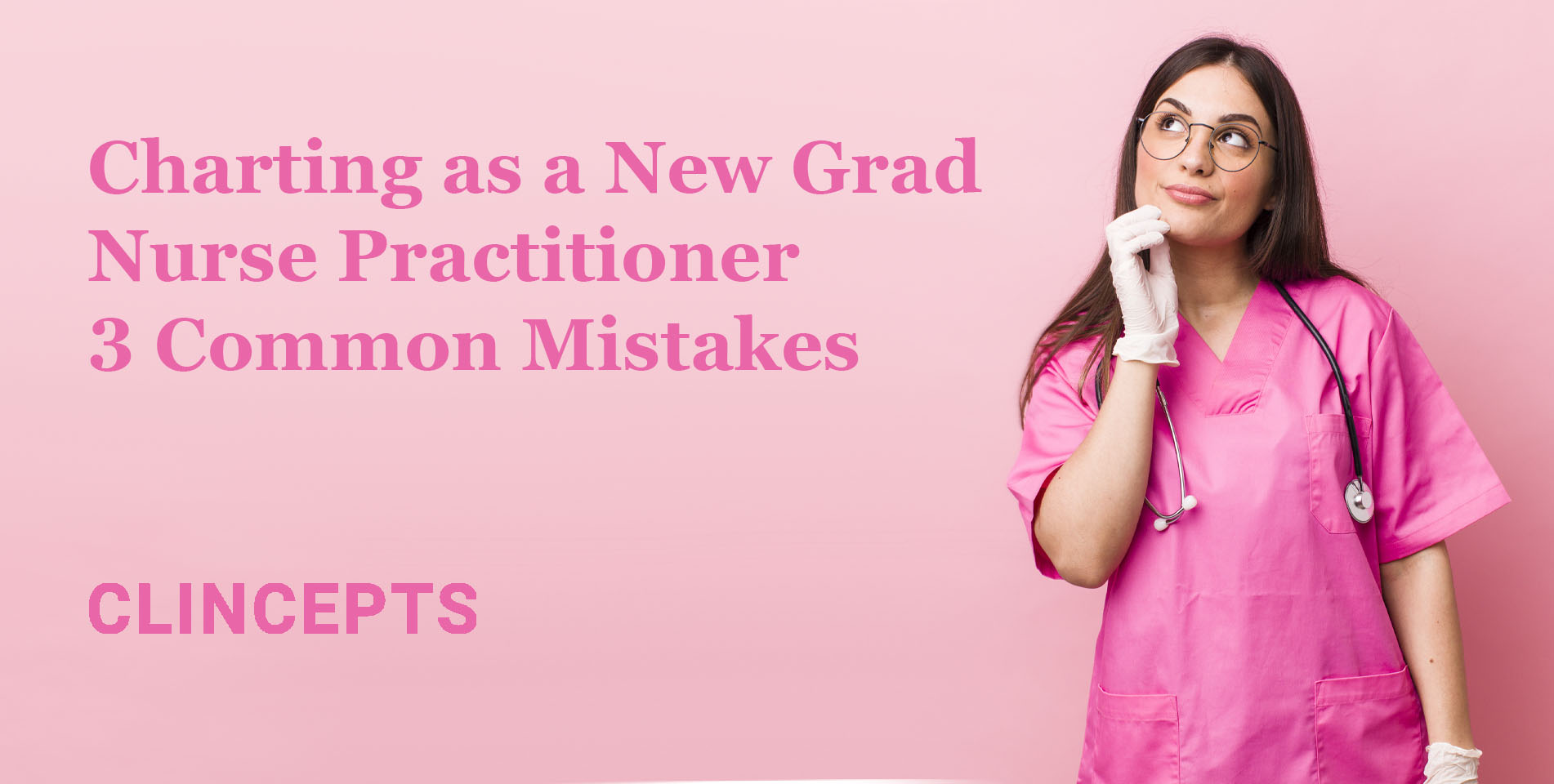Starting out as a new grad nurse practitioner can feel very overwhelming. There is such a significant learning curve going from RN to NP. New grad nurse practitioners often become overwhelmed with the increase in critical thinking, stress of clinical decision making, and the amount of work that needs to be done. Keeping up with charting as a new grad nurse practitioner seems to add a layer of stress and frustration.
As The Nurse Practitioner Charting Coach, I often see nurse practitioners overwhelmed by the amount of charting. So many nurse practitioners stay late at the office or bring their charts home. This disrupts the nurse practitioner’s work-life balance and is a significant risk factor for burnout.
With this experience as The Nurse Practitioner Charting Coach, I have discovered some common mistakes that I see new grad nurse practitioners make when charting. This article will look at three of those mistakes and provide tips for improvement.
Mistake #1: Over charting
Over charting, also known as “note bloat” is very common, especially for charting as a new grad nurse practitioner. We are used to charting very detailed, comprehensive notes on patients.
For example, if you were a RN who worked in an acute care setting, you were with your patient for 12 hours. You had to document everything from hourly rounding, to dressing changes/wound descriptions, to medications administered, to the size of their bowel movement. There is A TON of charting as a RN.
I often see over charting when charting as a new grad nurse practitioner. So many APRNs over chart because they are used to charting everything as a RN. However, a nurse practitioner who is seeing 25+ patients a day cannot create these detailed types of chart notes. Documentation needs to be problem-focused, short and sweet.
Another mistake I see in regards to charting as a new grad nurse practitioner is over charting to protect themselves legally. Many nurse practitioners think they need to add more information to help “cover their butt.”
This is actually not always the case. Sometimes the added information can actually increase the liability as nurse practitioners. For example, if you mentioned a certain symptom in the history of present illness (HPI) but you did not order any diagnostic tests or discuss in the plan of care, it will look negligent in a medical malpractice case. There is a fine line between adding enough information but not adding too much information.
In regards to charting as a new grad nurse practitioner, I recommend creating problem- focused, short and sweet chart notes. These types of notes not only take less time to create, but can actually be better off in terms of legal protection. Focus on the “chief complaint” or why the patient is being seen. Don’t make extra work for yourself like completing an entire review of systems or physical exam when it does not relate to the reason you are seeing the patient.
Mistake #2: Not utilizing smart phrases
There are many different charting time saving tips. But one that a lot of new grad nurse practitioners might not know about is using time saving tools within the electronic health record (EHR).
Charting as a new grad nurse practitioner should include the use of smart/dot phrases. Nurse practitioners that work in a certain field of medicine (i.e. primary care, urgent care, cardiology, pediatric gastroenterology, neuro ICU, etc.) often see the same “types” of patients.
For example, if you work in endocrinology, you will see a lot of diabetic patients, hypo/hyperthyroidism, etc. It will save you a ton of time to utilize smart phrases for these common visit topics.
Smart phrases, also known as dot phrases, are commonly used words or phrases that can quickly be implemented into the EHR. Pulling over these smart phrases can save a lot of time charting as a new grad nurse practitioner.
There are many topics of smart phrases that can be used. For example, smart phrases can include a portion of the history of present illness, a normal physical exam, plan of care instructions, patient education materials, etc. Most charting systems have the capability to add these smart phrases into the chart note.
I encourage new grad nurse practitioners to pay attention to what types of patients they frequently see. Are there certain phrases you constantly type out? Are there special discharge instructions you give the patient? Is there a procedure or physical exam that you constantly complete? Acknowledge what could be created into a smart phrase and on the frequency of the type of patients. It takes some work upfront, but can save you a ton of time in the long run!
For a free Jumpstart List of Smart Phrases for Nurse Practitioners or if you would like to look at some examples, click the link here.
Mistake #3: Not asking for help
Charting as a new grad nurse practitioner can be very overwhelming. And unfortunately, charting is not something that is properly taught in nurse practitioner school. I received one, maybe 45 minute lesson on how to chart and choose the correct Evaluation and Management code. When I started at my first job in primary care, I was overwhelmed with what I was supposed to chart.
I know a lot of other nurse practitioners learned how to create a SOAP note but the expectation was to create very comprehensive, detailed chart notes. Unfortunately, this is not feasible to do in real world practice.
Charting as a new grad nurse practitioner can be very overwhelming and many new NPs do not ask for help! As The Nurse Practitioner Charting Coach, I strongly recommend nurse practitioners ask questions not only about clinical practice but also in regards to charting. Here are a few charting resources to help you learn more!
Ask your colleagues.
Don’t be afraid to ask your coworkers and colleagues for help with charting as a new grad nurse practitioner. Remember that provider was once a newbie, and its’ likely they had the same challenges and thoughts of imposter syndrome that you do. Feel free to ask them for feedback on your charting. That provider may also have a list of smart phrases they are willing to share!
Ask your billing and coding expert.
Choosing the correct Evaluation and Management code is an important concept of charting as a new grad nurse practitioner. Even if you have a billing and coding expert, I think APRNs need to be aware of the billing and coding process to better their own documentation. If you are choosing the Evaluation and Management code, then be sure to learn more about it so you know you are doing it correctly. Don’t be afraid to reach out to more experienced providers for advice. Most healthcare institutions also have a billing and coding expert that you can email/chat with.
Learn from The Nurse Practitioner Charting School.
I created The Nurse Practitioner Charting School after noticing the lack of charting education in nurse practitioner school, along with the lack of charting resources in the real world practice. I talked with so many nurse practitioners who are dealing with a lack of work-life balance and nurse practitioner burnout. That is why I started The NP Charting School! I specialize in helping nurse practitioners to improve their charting so they can STOP charting at home!
If you are a new grad nurse practitioner making these three common mistakes, no worries! There is plenty of information and charting tips out there!



